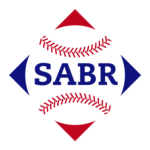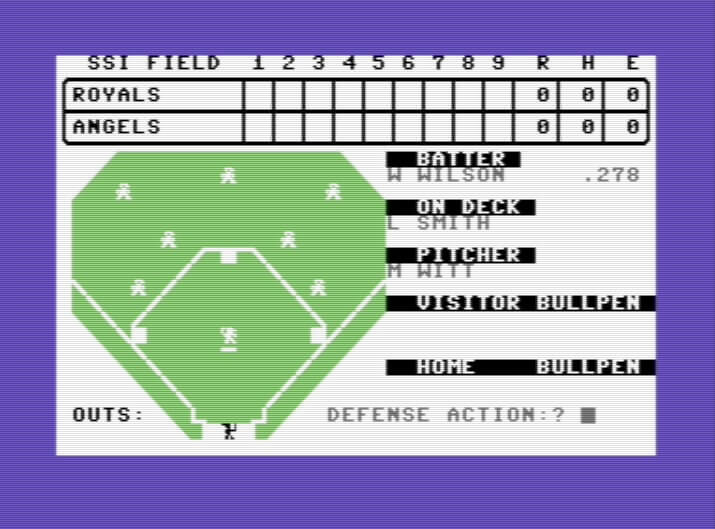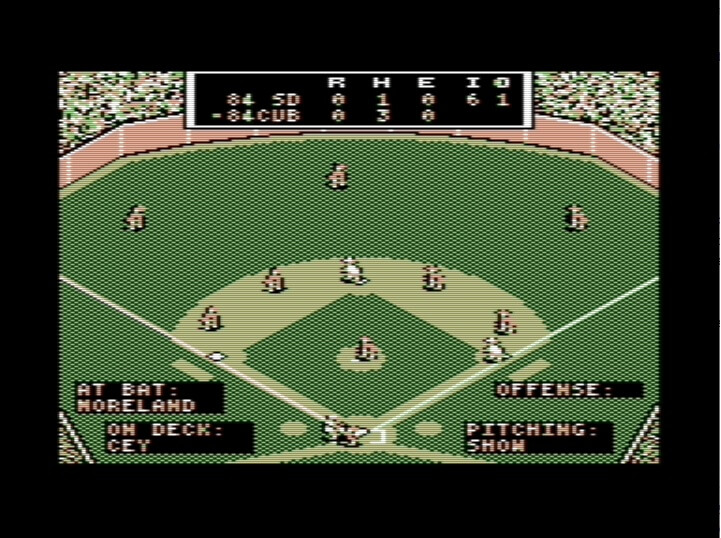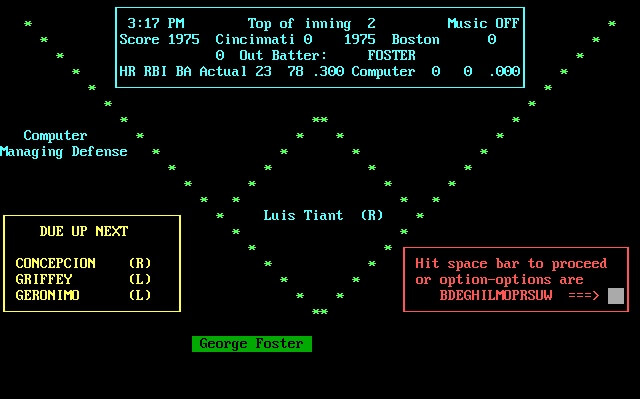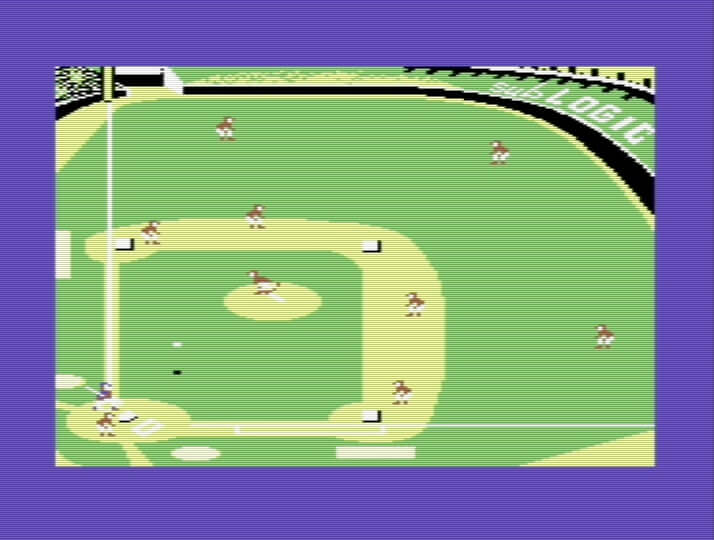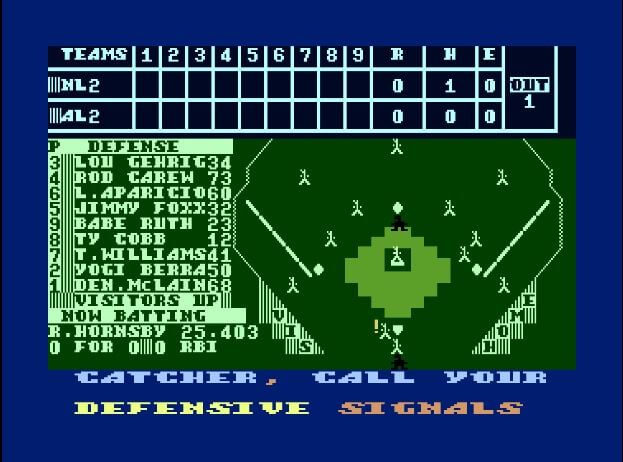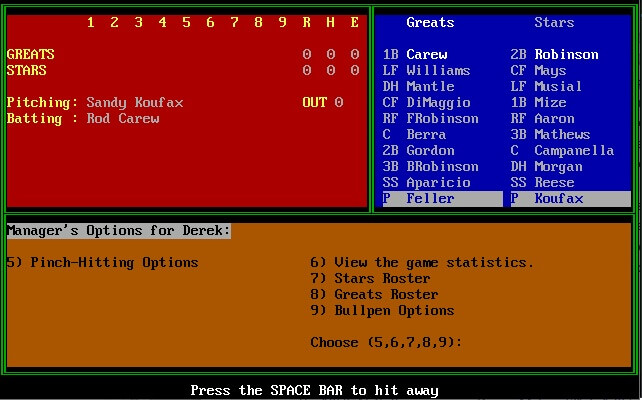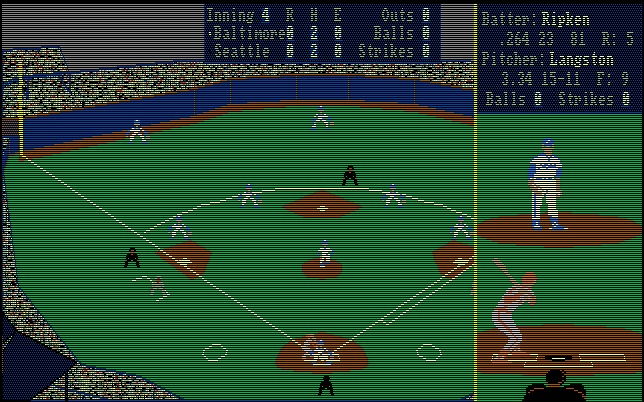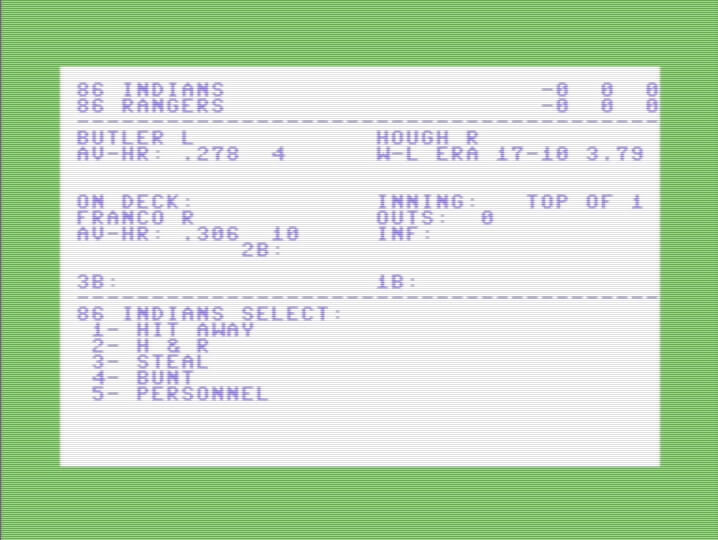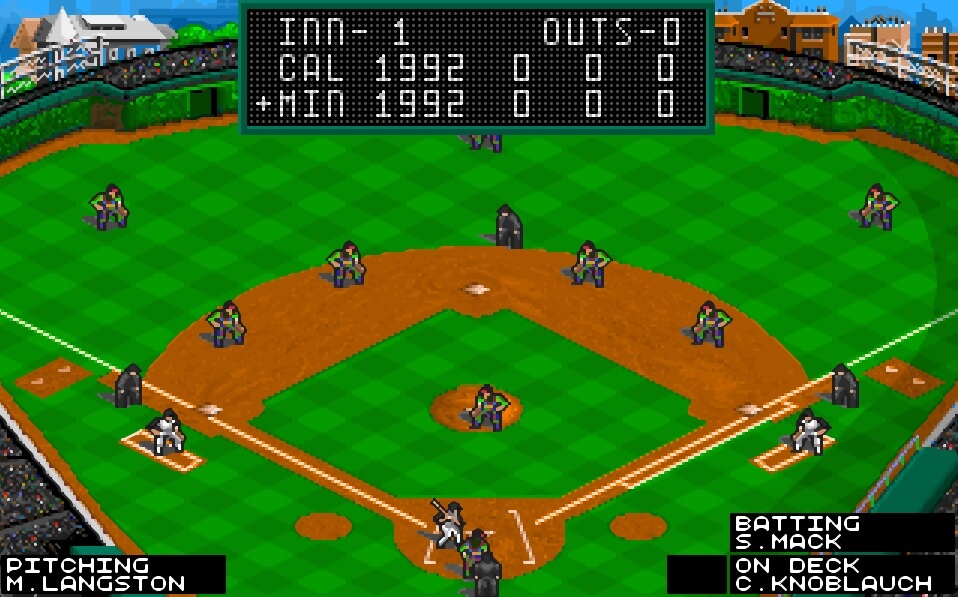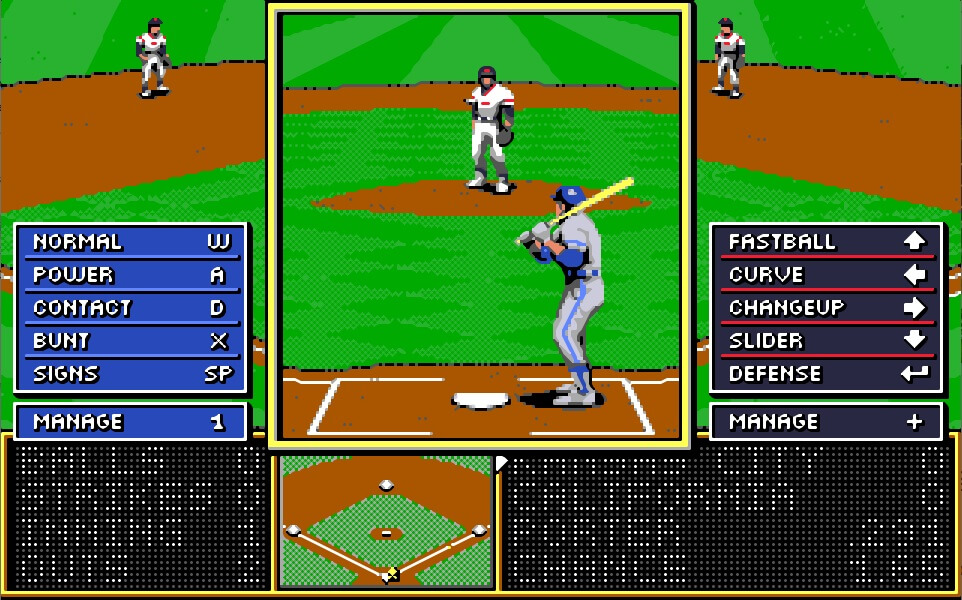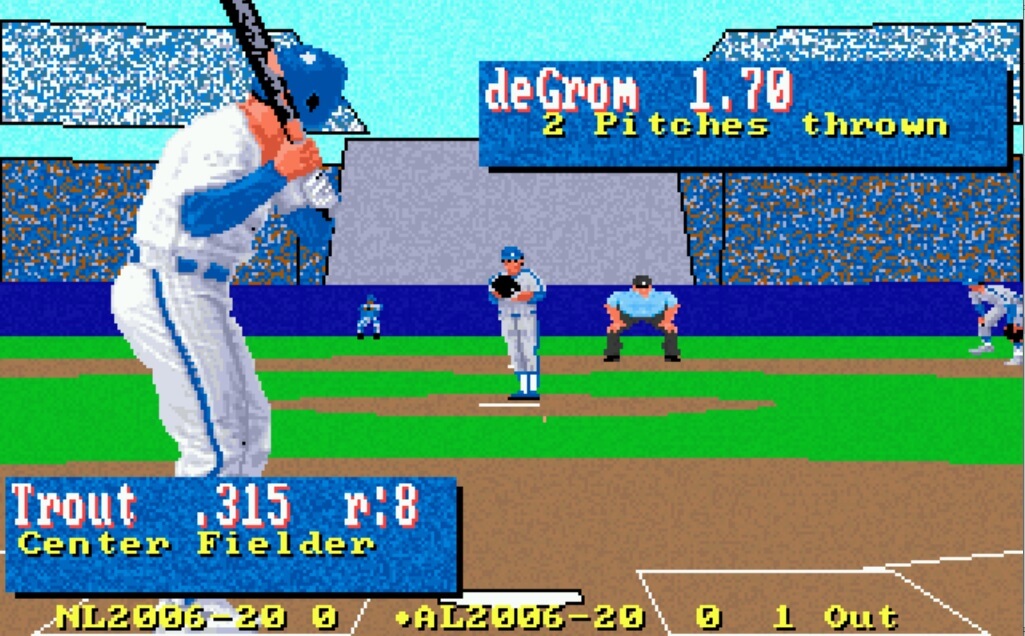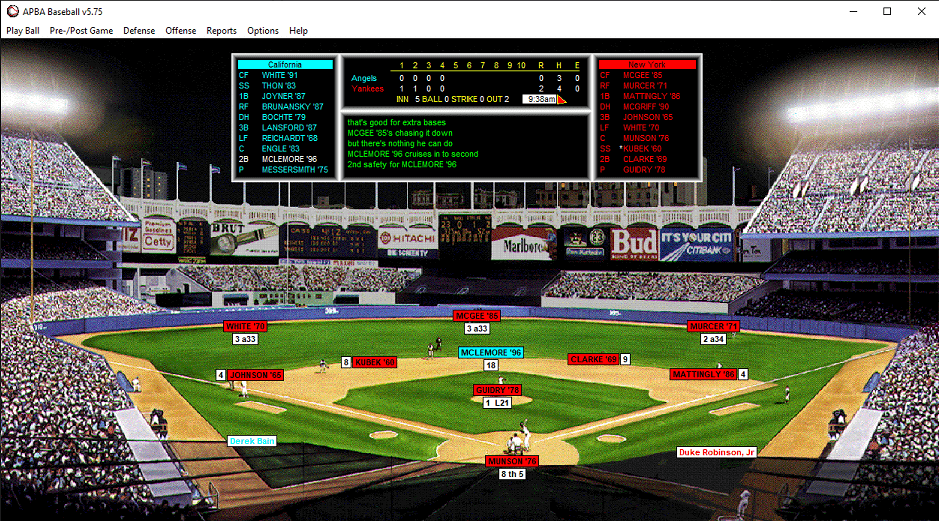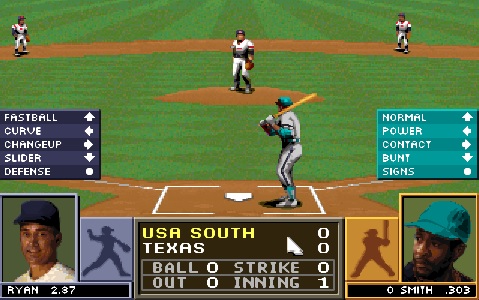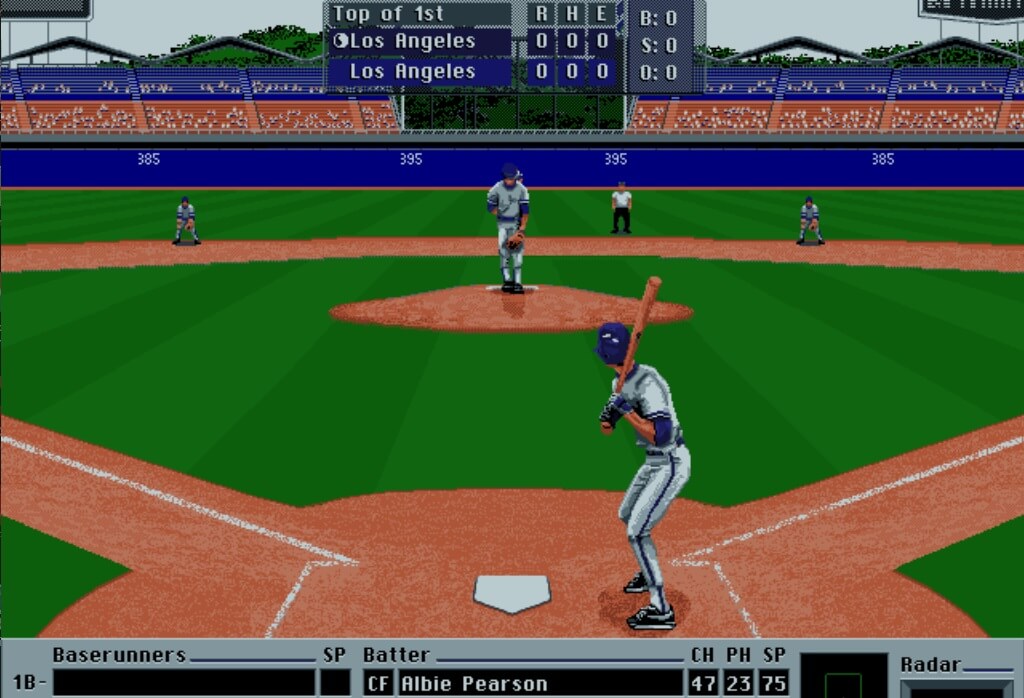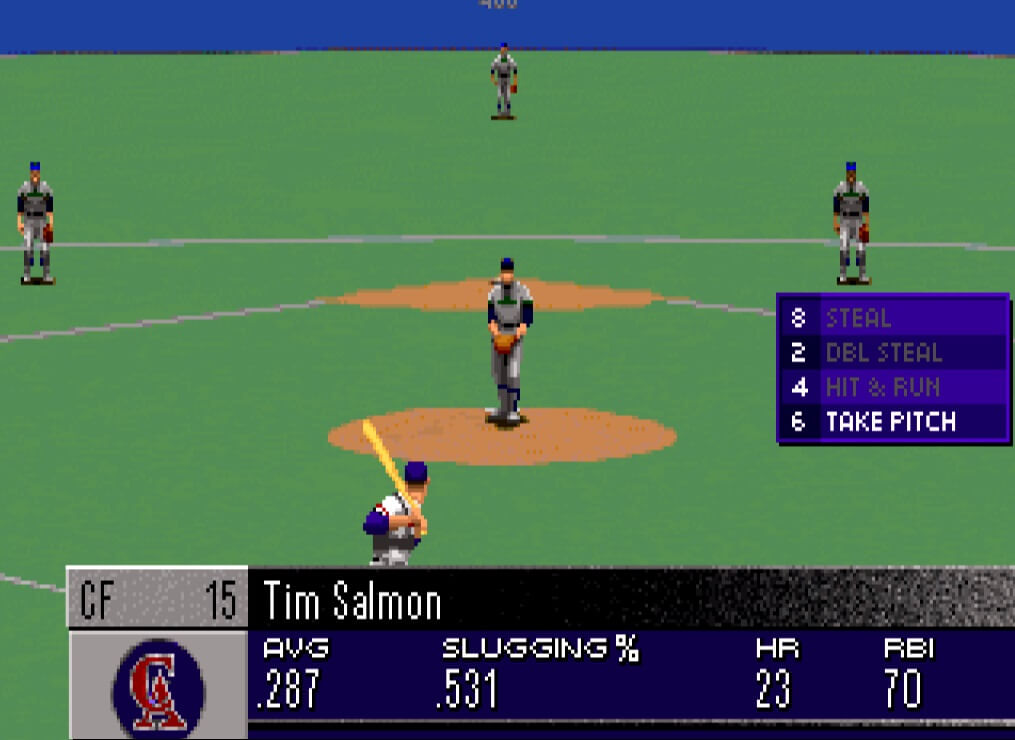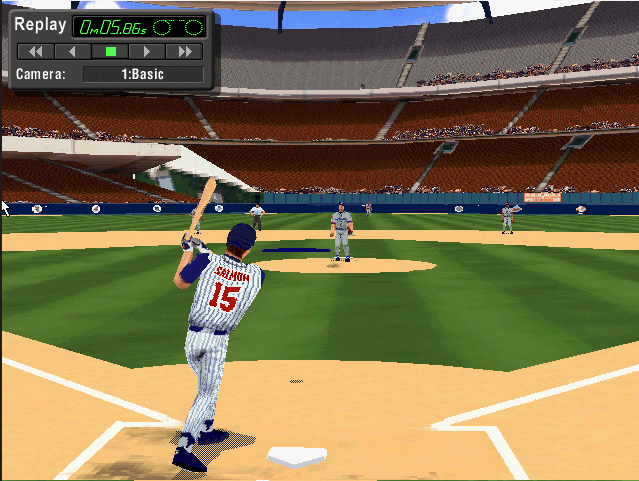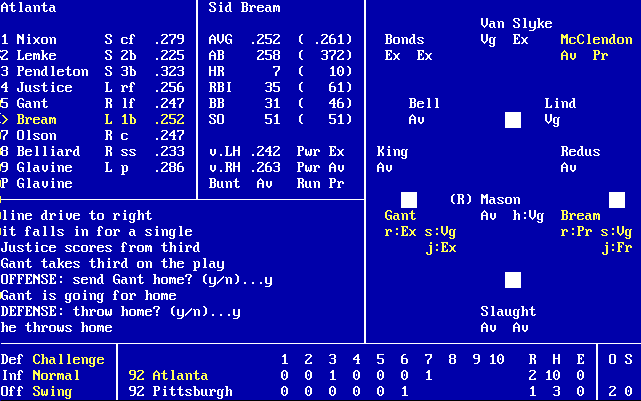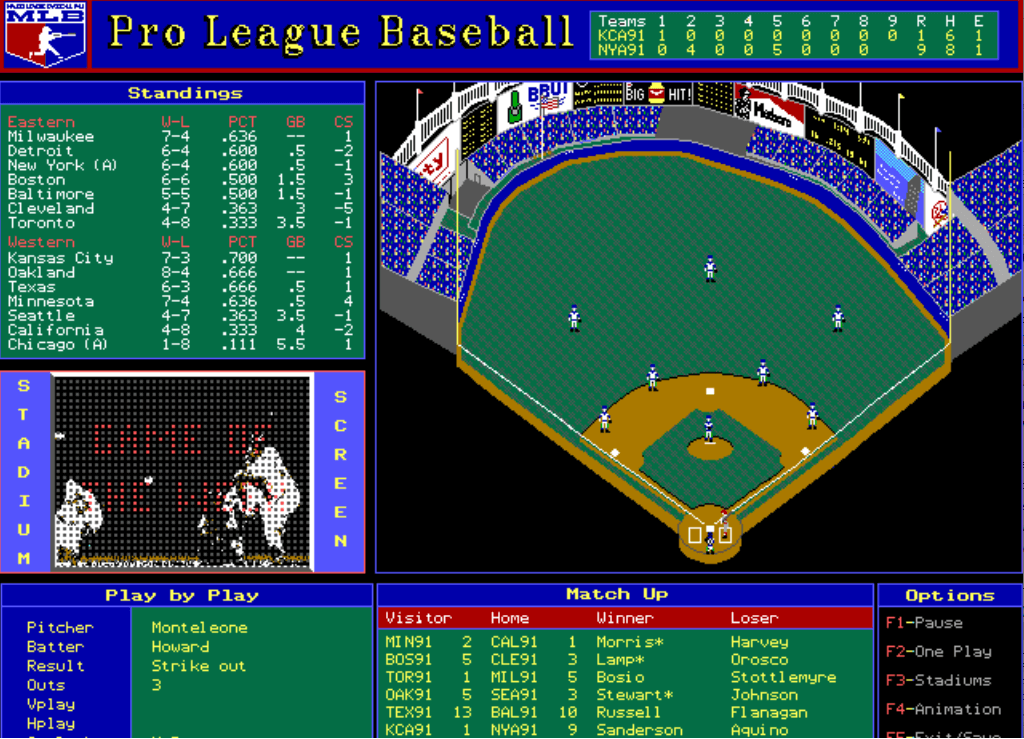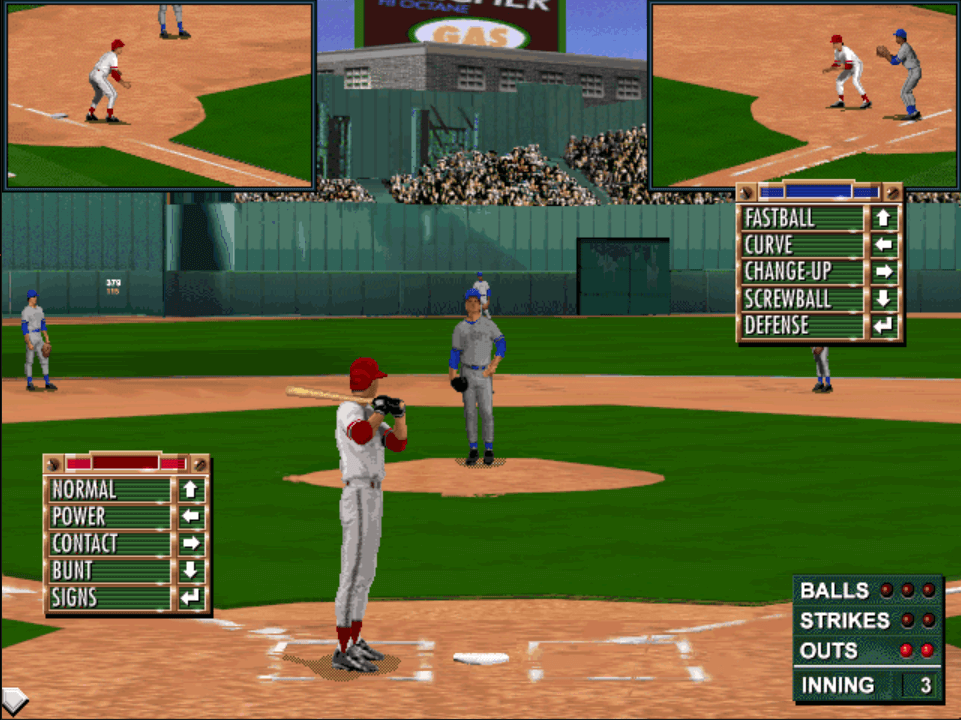This is the second entry in a series focusing on computer baseball simulations to supplement the chapter “Play Retro Baseball Video Games In Your Browser” from my Hardball Retroactive book along with the corresponding post at Hardball Retro. The series focuses on baseball simulations – games in which the primary emphasis is on managerial strategy and the ability to replay entire seasons with a degree of realism. Baseball video games that are strictly arcade representations of baseball (based solely on reflex and hand-eye coordination) are excluded.
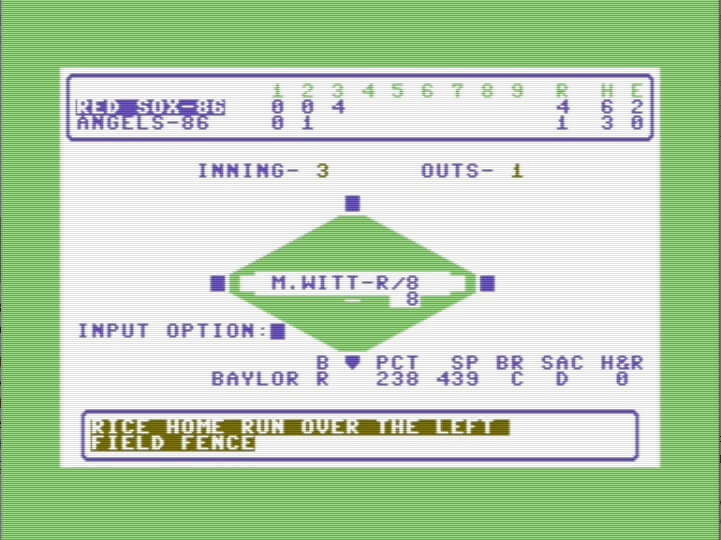
Publisher – The Avalon Hill Game Company
Release Year – 1983
Platforms – Apple ][, Commodore 64, TRS-80
Credits
| Game Design & Programming: | John Chance, Ken Russo and Richard Bamberg |
| Box Art: | Jim Talbot |
| Rules: | John Russo, Charles Kibler |
| Playtesters: | Chance Russo, Jim Reedy, Charles Kibler, Glenn Scanlon, Greg Handy, Lawrence McCauley |
Review
Computer Statis Pro Baseball evolved from a board game created by Jim Barnes in 1970. Statis Pro replaced the use of dice with a deck of Fast Action Cards which dictated the random events in the game (Wikipedia, Statis Pro Baseball). The computer version was published through Microcomputer Games, a division of the Avalon Hill Game Company which was responsible for the distribution of the board game.
I fired up the Commodore 64 edition of Computer Statis Pro Baseball in the VICE emulator. I was greeted with the Master Menu after viewing the introductory screen:
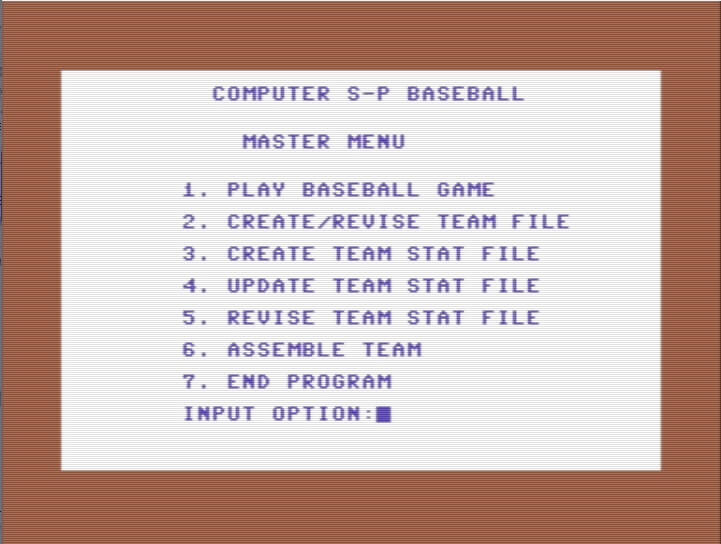
I selected option 1 which greeted me with the message “please wait approximately 2 and ¼ minutes”. The VICE emulator has a feature called Warp Mode which significantly speeds up the virtual floppy drive access times. Now I’m prompted to select the visiting team name. There is no list to select the team from – I need to either know the proper format (which might be indicated in the manual) or perform a listing of the team disk directory prior to loading the game. Using the “Attach Disk Image” option in VICE, I was able to view the contents of the team disk and determine that the teams are stored in the following format: Angels-86, A’s-86, etc.
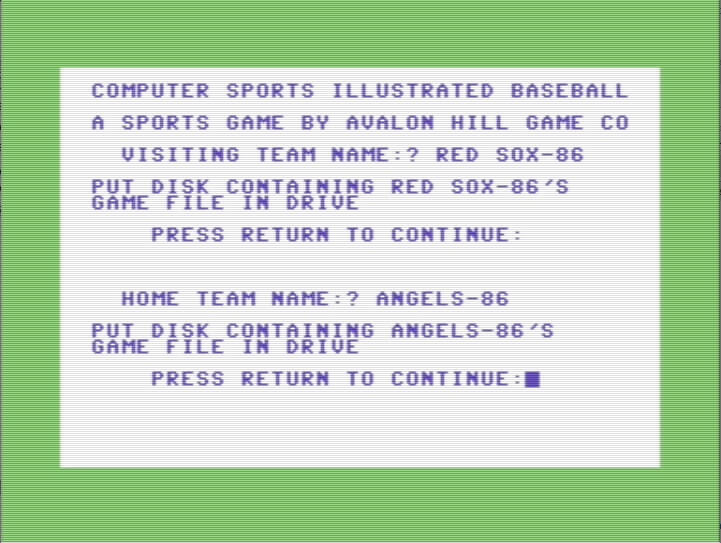
I played a 3-game series (Red Sox-86 at Angels-86) to refresh my memory as I had not played this game since the mid-Eighties.
Game 1 showcased Boston fire-baller and 1986 AL Cy Young Award winner Roger Clemens (24-4, 2.48) against California’s top starter, Mike Witt (18-10, 2.84). The Halos drew first blood in the second frame. Rob Wilfong stroked a base hit with 2 outs. Consecutive errors by Jim Rice and Clemens allowed Dick Schofield and Bob Boone to reach safely. Gary Pettis punched a single to center field, scoring Wilfong. Wally Joyner ended the threat with a ground out to the third baseman, Wade Boggs. The Sox answered in the top of the third inning. Rey Quiñones laced a two-base hit to lead off the frame. Boggs tipped his cap after flailing at Witt’s curveball for strike three. Marty Barrett slashed a double to the opposite field, knotting the score at 1-1. After a Bill Buckner base knock placed runners on the corners with only one out, Jim Rice promptly hammered Witt’s fastball over the left field fence for a 3-run homer. Tony Armas extended Boston’s advantage to 5-1 with a blast to center field to start the sixth inning. Doug Corbett relieved Witt and retired the side. In the bottom of the sixth, I encountered a rare play. Reggie Jackson and Doug DeCinces reached base on successive singles. With Ruppert Jones at the dish, the event text displayed “Checking Quiñones’ range…” Subsequently I learned that the Angels rally had been quashed: “R. Jones line out to shortstop – Triple Play”. Armas struck again, belting a 2-run triple off Corbett with 2 outs in the seventh. Terry Forster entered the contest with the Angels trailing 7-1 to face Rich Gedman. He retired the backstop on a ground ball to second to close out the frame, but yielded 3 consecutive hits to begin the eighth inning. Rookie left-hander Chuck Finley jogged to the mound to mop up. Buckner lifted a fly ball to left and I received a prompt regarding whether to send the runner on third: “Option Percentage 76% – Input “Y” to advance, “N” to hold runner”. I elected to hold Boggs at third base as the Sox had their cleanup hitter due up with only 1 out. Rice plated Boggs with a single to right field, the sixteenth safety for the Sox. Clemens entered the ninth inning with a 9-1 cushion. “Mr. October” connected on a towering solo shot to left field, padding his Hall of Fame credentials. DeCinces reached on an error and Wilfong walked after Jones whiffed. Jack Howell pinch-hit for Schofield as Clemens hoped to nail down the complete game victory. Another fielding range check resulted in a fly out to right field. Down to their final out, Rick Burleson was sent to the plate to bat for Boone. The “Rooster” bounced a two-hopper to Barrett for the final out.
The second contest pitted Dennis “Oil Can” Boyd (16-10, 3.78) against Kirk McCaskill (17-10, 3.36). Boston continued firing on all cylinders as Jim Rice plated the first run on an RBI ground out to shortstop following a Wade Boggs single and a Marty Barrett double. California tied the score in the bottom of the third. Dick Schofield and Bob Boone slashed successive safeties, placing runners at the corners with no outs. Boyd whiffed Gary Pettis, but Wally Joyner followed with a hard grounder towards first base which skipped off Bill Buckner’s glove, scoring Schofield. Boyd escaped further damage when he struck out Brian Downing and got Reggie Jackson on a line drive to right fielder Dwight Evans. The Halos took the lead in the bottom of the 4th on a 3-run circuit clout off the bat of second-sacker Bobby Grich. Boyd escaped further damage and remained on the bump into the sixth frame. After a leadoff single by Ruppert Jones and a walk to Grich, Boyd was relieved by Steve Crawford. Pettis delivered a base hit to right, loading the bases after Crawford retired Schofield and Boone. Joyner lined sharply to Barrett to extinguish the threat. Boston loaded the bases in the top of the 7th, but McCaskill got Ed Romero on a foul pop fly to Boone for the second out of the inning. Boggs scalded a hot grounder to Grich, who gloved it and flipped the ball to Joyner to retire the side. The Red Sox threatened again in the eighth, placing runners on first and second with two outs. Doug Corbett, who had replaced McCaskill to start the frame, elicited a pop-up to Schofield to quell the rally. Joe Sambito came on to pitch the bottom of the eighth inning. California sent Rick Burleson to the dish to substitute for Jones. Burleson drilled a one-hopper up the middle which deflected off Sambito for an infield hit. George Hendrick, batting for Boone with two down, lined out to Barrett. I was immediately prompted to edit my lineup to assign defensive positions to Burleson (SS) and Hendrick (RF). Jerry Narron was inserted as the catcher, batting in Schofield’s slot. Donnie Moore nailed down the 4-1 victory. He conceded a single to pinch-hitter Steve Lyons with two outs in the ninth, but got Boggs on a fly ball to Pettis to close out the game.
Southpaw Bruce Hurst (13-8, 2.99) opposed veteran right-hander Don Sutton (15-11, 3.74) in the third match. Hurst wriggled in and out of trouble in the opening frame. With two outs, California loaded the bases on 3 consecutive base knocks by Brian Downing, Doug DeCinces and George Hendrick. Marty Barrett snared a line shot by Bobby Grich to help Hurst out of the jam. Jim Rice launched an opposite-field blast to put the Red Sox on the board in the top of the second inning. The apparently not-so-rare “Line out to shortstop – Triple Play!” allowed Sutton to escape the third frame unscathed following back-to-back base hits by Steve Lyons and Wade Boggs. The wily veteran pulled another Houdini act in the sixth. Boggs and Barrett delivered successive singles, and then moved up 90 feet on a Bill Buckner ground out. The Angels elected to walk Rice intentionally. With the bases juiced, Don “Groove” Baylor lifted a harmless fly to left. Gary Lucas and Doug Corbett survived the eighth inning despite permitting another bases loaded situation. In the bottom half with Hurst and the Sox clinging to a 1-0 lead, speed demon Gary Pettis led off with a clean single to center field, stole second and advanced to third on a slow grounder by Rick Burleson. Hurst struck out Wally Joyner for the second out. Downing coaxed a walk to set up runners on first and third for the cleanup hitter, DeCinces. Bob Stanley entered the contest and got DeCinces on a line drive to Buckner. Terry Forster held the Sox scoreless in the visitor’s half of the ninth. After pinch-running for Hendrick earlier in the contest, Ruppert Jones stepped to the plate for his first at-bat to commence the bottom of the 9th. Jones crushed Stanley’s first offering over the center field fence, tying the score at 1-1! Grich drew a walk, but Dick Schofield popped out to Buckner on a sacrifice bunt attempt for the first out. Bob Boone got the bunt down but Rich Gedman pounced on it and pegged a bullet to second base to get the lead runner. Pettis lofted a fly ball to Dwight Evans, sending the game into extra innings. Donnie Moore relieved Forster to start the 10th. Buckner doubled up the right-field gap with one away and the Angels decided to walk Rice intentionally. Baylor slashed a worm-killer towards Grich, and the slick-fielding Halos turned the 4-6-3 double play. Boston inserted Calvin Schraldi to open the bottom of the 10th and he responded with a clean inning including back-to-back punch outs of Burleson and Joyner. Evans and Gedman produced consecutive singles and moved up on a sacrifice bunt by Ed Romero. Tony Armas drove in the go-ahead run with an opposite-field bloop single that landed in-between Joyner, Grich and a hard-charging Jones. Chuck Finley replaced Moore on the bump to face Boggs. California minimized the damage when Boggs lined out to DeCinces and Barrett slapped a hard grounder back to the box. Schraldi returned to the hill to face the Angels 4-5-6 hitters. DeCinces and Jones went down swinging, giving Grich the final chance to extend the match. Grich hit a slow dribbler in front of home plate. Gedman corralled it and threw to Buckner as the Red Sox triumphed 2-1 in 11 innings.
Ratings
Graphics – [1] The layout is comparable to SSI Computer Baseball, but in some ways more limited than its predecessor. The line score is presented at the top with the current inning and number of outs shown directly below the scoreboard. Players are not depicted at all – the infield is a green diamond with the pitcher’s name and ratings centered over the mound. The batter’s name is displayed below home plate along with handedness, batting average, slugging percentage and 3 ratings: base running, sacrifice and hit & run ability. When a base is occupied, the corresponding base runner is denoted. The play-by-play account appears in a 2-line box at the bottom of the screen.
Sound – [2] The Commodore 64 version produced distinctive sound effects depending on the type of hit. Outs were denoted with a quick horn blast while strikeouts are marked with a protracted buzzer effect. Walks and successful stolen base attempts elicited the first few bars of “Charge!” while errors provoke a mocking refrain. A siren resonates for every home run. The ballpark organ belts “One, two, three strikes you’re out at the old ball game” upon the conclusion of each contest.
Strategy – [2] Prior to every at-bat, the manager is presented with a single Input Option prompt (you don’t receive separate prompts for offense and defense). Pressing “M” during the game brings up the Menu screen, which lists the assorted in-game options. It is not possible to warm up a pitcher – you simply substitute them as needed. Defensively, the user is limited to two choices: infield in/out and intentional walk. There are a handful of offensive decisions available to the manager: steal, hit & run, sacrifice bunt, bunt for hit and squeeze bunt.
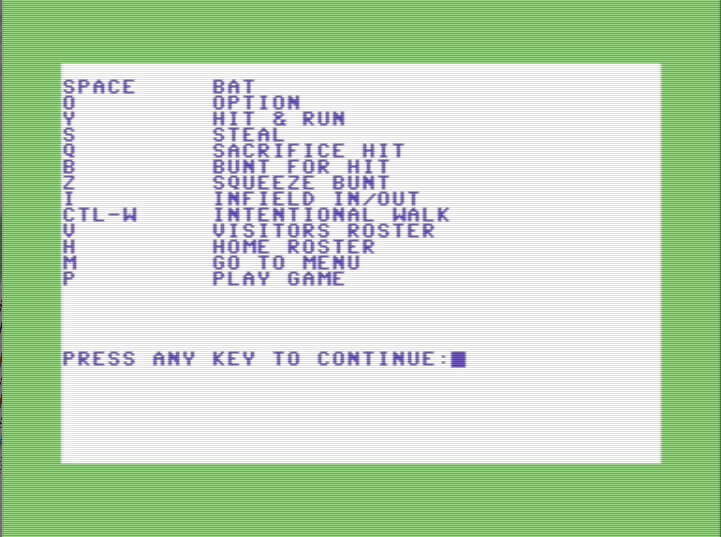
Artificial Intelligence – [1] There is no artificial intelligence as the game does not include an option to play against the computer. You can either manage the visiting and home squads or a battle against a real-life opponent.
Box Score – [2] The program asks the user to assign the winning, losing and saving pitchers before asking if you want to view the box score, print a copy and/or assign a date. The results are output to the screen in the same manner as if they were sent to your printer. The lines will eventually scroll (there is no pause between showing the visitor or home box score). Extra base hits, strikeouts, walks, hit batsmen, stolen bases, and errors along with the winning, losing and saving pitchers are all itemized at the bottom of the box score. One quirk that I observed – while the lineup is presented correctly in order from the first to the ninth batter, the pinch hitters are listed at the bottom, making it difficult to discern who they replaced. Also, the triple plays were absent from the box score. I was prompted with the option to save the results to disk. I am uncertain as to whether this game offered the option to compile stats. Regrettably I was unable to locate the manual.
Rosters – [1] Each team consists of a 25-man roster (15 batters and 10 pitchers). There are no expanded rosters. My version included 2 disks. One contained all teams from the 1986 season while the other (Famous Teams #1) included 18 teams from past seasons along with 2 “Hall of Fame” teams (American and National).
Statistics – [2] Choosing option 2 (Create/Revise Team File) from the main menu allows the user to edit the data from an existing team. Batter and pitcher statistics include the standard counting numbers. Ratings consist of Range, Arm, Base Running, Stolen Base and Clutch Hitting for batters while pitchers are limited to Control and Range. You also have the ability to look at a batter or pitcher’s “string” which contains calculated grades that the user is unable to modify, such as Injury (batters) along with Stamina and Relief Stamina (pitchers).
Usage/Injuries/Ejections – [1] No injuries occurred during the 3-game exhibition series that I played. Batters have an injury rating and pitchers have 2 stamina grades which gave me the impression that injuries are possible although I could not locate any reference to injuries or ejections when I reviewed the listing from the “GAME.PRG” file. You need to manually track player usage and statistics if you’re planning to replay a series or a season’s worth of games. I did not find an option to compile stats.
Ballparks / Park Factors – [1] The simulation does not appear to account for any park factors.
Commentary – [2] Two lines of text are presented at the bottom of the screen. The outcomes of each at-bat are posted with the player’s name along with a concise description of the result (“D. Evans hard ground out to second base”). Home runs are preceded by a broadcaster’s lead-in such as “It’s a long fly ball to center field.” After a momentary pause, the conclusion is revealed: “Armas home run over the center field fence.”
Scale: Ratings from 1 (worst) to 5 (best)
Total Score: 15 out of 50
Observations
My enthusiasm for Computer Statis Pro Baseball was mitigated by the dearth of options, absence of a computer opponent and inability to compile statistics. The suspension of disbelief came sharply into focus when the second triple play occurred within the span of 3 games. Retrosheet.org keeps a log of all triple plays on their Noteworthy Events page. Since 1900 only 576 triple plays have been recorded (less than 5 per year), so observing 2 in a 3-game series strains credibility. Recommended for completists and those seeking a quick rush of nostalgia for the golden era of micro computing…
Please add a comment below if you spent a significant amount of time and/or have any recollections of Computer Statis Pro Baseball.
Screenshots
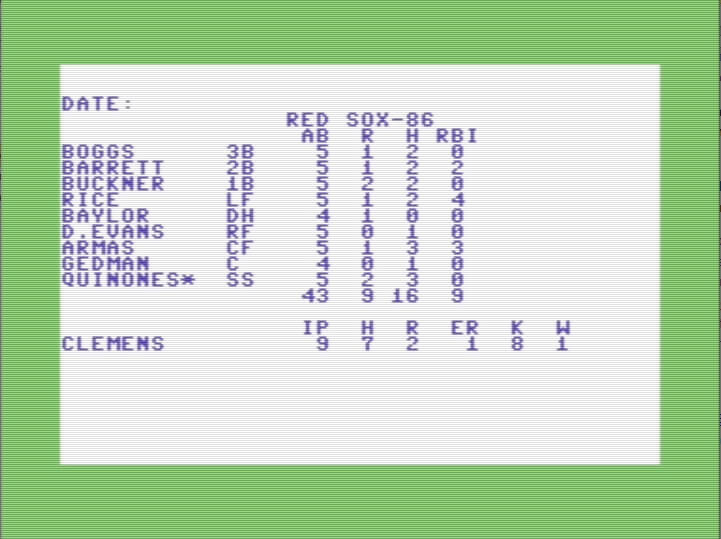
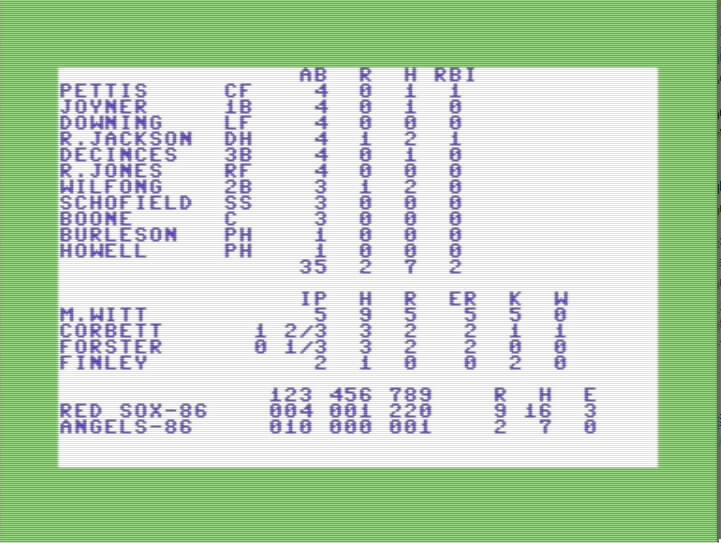
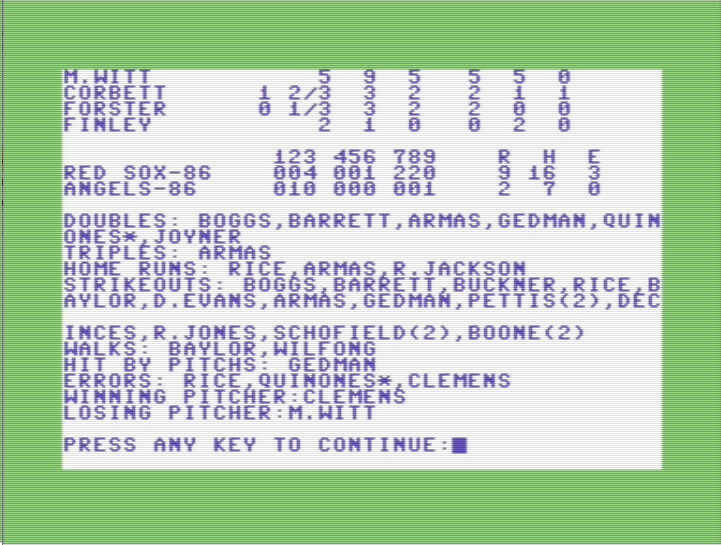
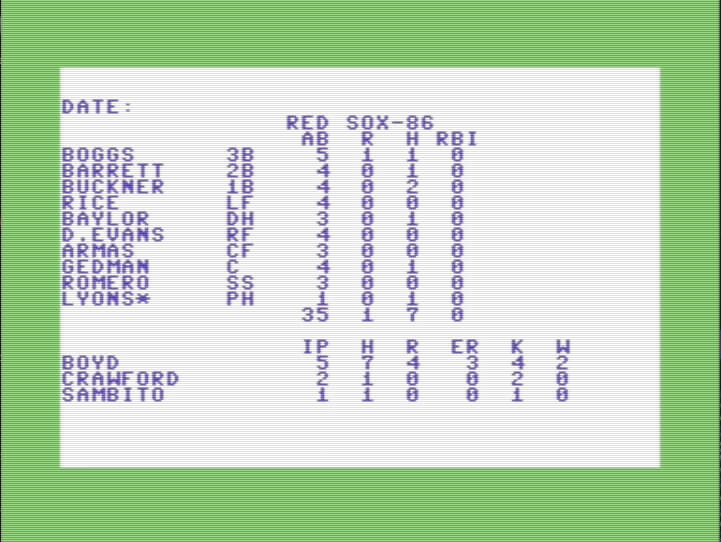
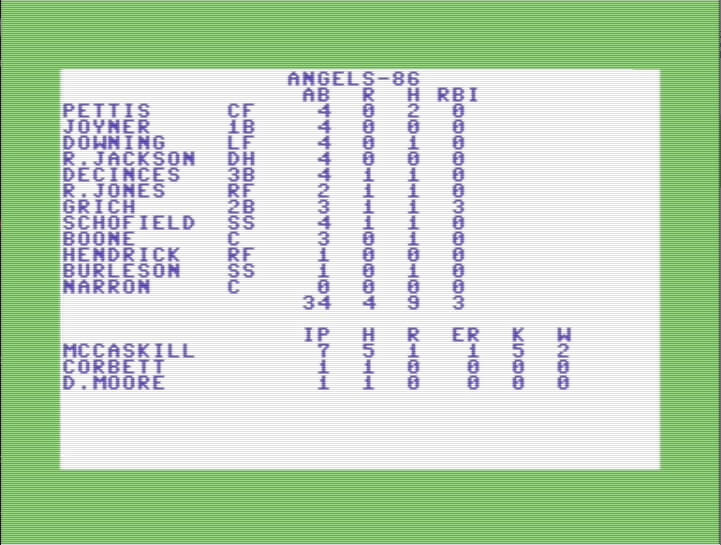
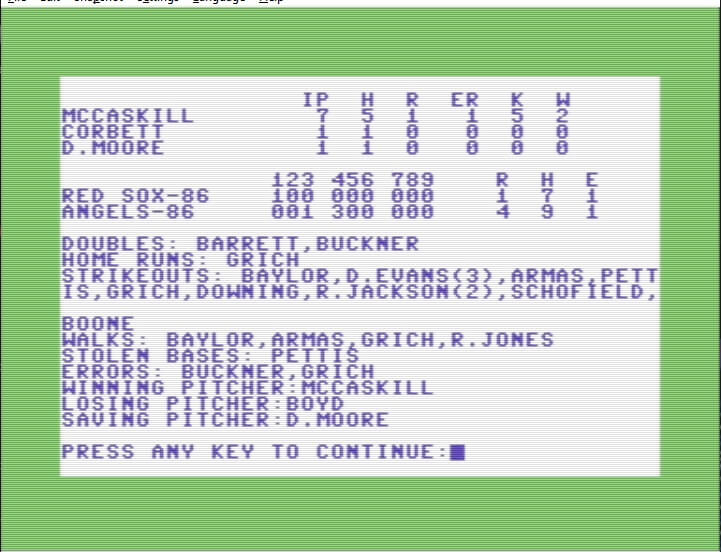
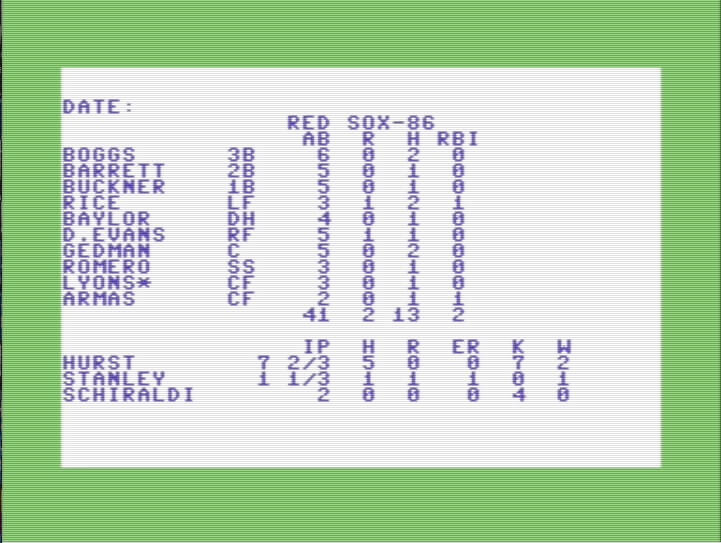
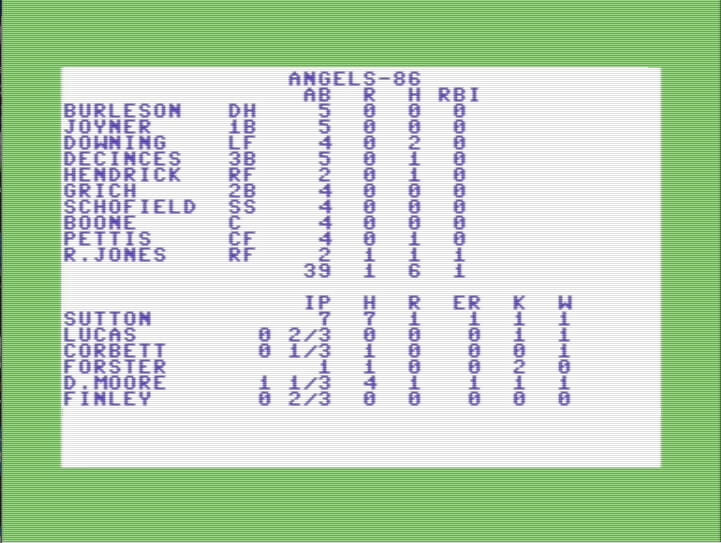
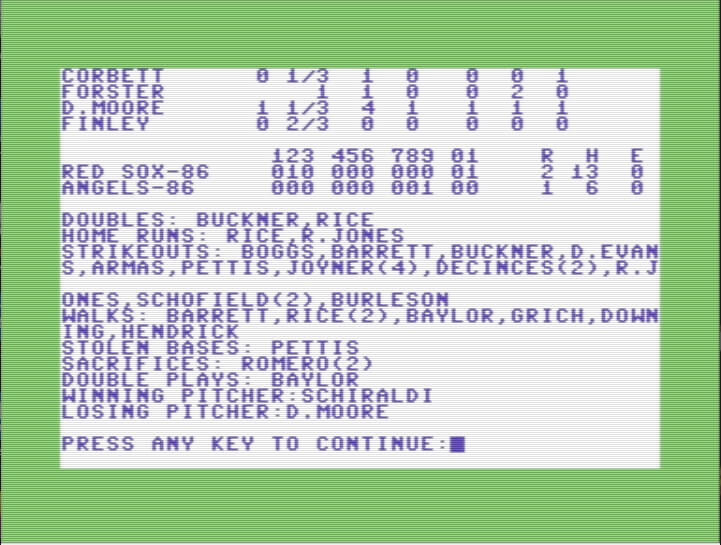
Articles in the Series
Additional Links
Play Computer Statis Pro Baseball in your browser! –
https://archive.org/details/Computer_Statis-Pro_Baseball_1986_Avalon_Hill_Disk_1_of_2_Side_A
*NOTE* – I was unable to get past the intro screen on the archive.org link and encountered a similar issue attempting to run this software in the Vice emulator. I edited the “HELLO” file to load the “Master Menu” program instead of the “AH” (Avalon Hill) intro screen. I contacted the Internet Archive to advise them of this workaround. As of 8/27/2019 the fix had not been implemented.
Playthrough – HardballRetro
Peschel, William. “View From The Dugout – Major League Baseball on the Computer.” Computer Gaming World, May 1986, Volume 28. pgs 19-20, 45. http://www.cgwmuseum.org/galleries/issues/cgw_28.pdf
https://www.mobygames.com/game/computer-statis-pro-baseball
http://www.stadium64.com/gameinfos/statisprobaseball/statisprobaseball.htm
https://en.wikipedia.org/wiki/Statis_Pro_Baseball
Retrosheet – Triple Plays – https://www.retrosheet.org/TriplePlays.htm
Statis Pro Baseball Online – https://www.statisprobaseballonline.com
Statis Pro Baseball – Wikipedia entry – https://en.wikipedia.org/wiki/Statis_Pro_Baseball
About the Author
I am a New Jersey native with a passion for baseball, statistics, computers and video games who enjoys spending quality time with his family.
“Hardball Architects – Volume 1 (American League)“, published in July 2020 and
“Hardball Architects – Volume 2 (National League)”, published in April 2022, examine the trades, free agent acquisitions, draft picks and other transactions for the 30 Major League Baseball franchises, divided into a 2-volume set. Both books are available in paperback and digital (Kindle) format at Amazon.com. All key moves are scrutinized for every team and Sabermetric principles are applied to the roster construction throughout the lifetime of the organization to encapsulate the hits and misses by front office executives. Team performances are analyzed based on transaction type with graphs depicting the WAR (Wins Above Replacement) in every decade. Individual results for each player-transaction is charted over the duration of their stint with the franchise. Every team chapter includes All-Time Rosters and Single-Season Leaders based on transaction type. The Team Trade Record chronicles the WAR and WS (Win Shares) accumulated by players acquired in comparison to those traded to opposing teams. The opening chapter is devoted to the Evolution of the General Manager and incorporates a discussion with former Dodgers GM Fred Claire (along with former Angels and Red Sox GM Mike Port and current Reds GM Nick Krall in Volume 2) on a variety of front office topics.
“Hardball Retroactive”, published in June 2018, is available in paperback and digital (Kindle) format at Amazon.com. Hardball Retroactive is a modest collection of selected articles that I have written for Seamheads.com along with my Baseball Analytics blog since 2010. Exclusive content includes the chapter on “Minors vs. Majors” which assesses every franchise’s minor league successes and failures in relation to their major league operations.
“Hardball Retrospective” is available in paperback and digital (Kindle) format at Amazon.com. Supplemental Statistics, Charts and Graphs along with a discussion forum are offered at TuataraSoftware.com. In Hardball Retrospective, I placed every ballplayer in the modern era (from 1901-present) on their original teams. Using a variety of advanced statistics and methods, I generated revised standings for each season based entirely on the performance of each team’s “original” players. I discuss every team’s “original” players and seasons at length along with organizational performance with respect to the Amateur Draft (or First-Year Player Draft), amateur free agent signings and other methods of player acquisition. Season standings, WAR and Win Shares totals for the “original” teams are compared against the real-time or “actual” team results to assess each franchise’s scouting, development and general management skills.
Don Daglow (Intellivision World Series Major League Baseball, Earl Weaver Baseball, Tony LaRussa Baseball) contributed the foreword for Hardball Retrospective. The foreword and preview of my book are accessible here.
“Hardball Retrospective – Addendum 2014 to 2016” supplements my research for Hardball Retrospective, providing retroactive standings based on Wins Above Replacement (WAR) and Win Shares (WS) for each “original” team over the past three seasons (2014-2016). Team totals from 2010 – 2013 are included for reference purposes. “Addendum” is available in paperback and digital (Kindle) format at Amazon.com.
NOTE: Original article posted on the Hardball Retro website, August 27, 2019.
A lifelong resident of central New Jersey, I enjoy spending quality time with my wife and three children. In my professional life I’ve worked for three local healthcare systems as a server and network administrator over the last 30 years. Co-chair of the SABR Games and Simulations Committee since August 2022 along with Mark Wendling.
My hobbies include baseball, statistics, computers and video games along with freshwater fishing. I have authored five books and contributed articles to Seamheads, Fangraphs and my site, Hardball Retro. Follow my HardballRetro channels on Twitch for live-streaming of classic and current baseball video games and view the resulting playthrough videos on YouTube!
Visit my Amazon author page to check out my books, promotional videos, and post a review if you're a Hardball Retro fan!
My Books:
"Hardball Retro’s Compendium of Baseball Video Games and Electronic Handhelds," published in September 2024 with co-author John Racanelli, is available in paperback and digital (Kindle) format at Amazon.com.Hardball Retro’s Compendium of Baseball Video Games and Electronic Handhelds was recognized with the 2025 Sporting News-SABR Baseball Research Award.
“Hardball Architects – Volume 1 (American League Teams)”,published in July 2020, is available in paperback and digital (Kindle) format at Amazon.com.
“Hardball Architects – Volume 2 (National League Teams)”,published in April 2022, is available in paperback and digital (Kindle) format at Amazon.com.
“Hardball Architects” examines the trades, free agent acquisitions, draft picks and other transactions for the 30 Major League Baseball franchises, divided into a 2-volume set (American League and National League). All key moves are scrutinized for every team and Sabermetric principles are applied to the roster construction throughout the lifetime of the organization to encapsulate the hits and misses by front office executives.
“Hardball Retroactive”,published in June 2018, is available in paperback and digital (Kindle) format at Amazon.com. A cross-section of essays that I penned for Seamheads.com along with my Baseball Analytics blog spanning nearly a decade touching on subjects including "Taking the Extra Base", "General Manager Scorecard", "Worst Trades", "BABIP By Location" and "Baseball Birthplaces and the Retro World Baseball Classic". Rediscover your favorite hardball arcade and simulations in "Play Retro Baseball Video Games In Your Browser" or take a deep dive into every franchise's minor league successes and failures in relation to their major league operations in "Minors vs. Majors".
“Hardball Retrospective” is available in paperback and digital (Kindle) format at Amazon.com.Supplemental Statistics, Charts and Graphs along with a discussion forum are offered at TuataraSoftware.com. In Hardball Retrospective, I placed every ballplayer in the modern era (from 1901-present) on their original teams. Using a variety of advanced statistics and methods, I generated revised standings for each season based entirely on the performance of each team’s “original” players. I discuss every team’s “original” players and seasons at length along with organizational performance with respect to the Amateur Draft (or First-Year Player Draft), amateur free agent signings and other methods of player acquisition. Season standings, WAR and Win Shares totals for the “original” teams are compared against the real-time or “actual” team results to assess each franchise’s scouting, development and general management skills.
Don Daglow (Intellivision World Series Major League Baseball, Earl Weaver Baseball, Tony LaRussa Baseball) contributed the foreword for Hardball Retrospective. The foreword and preview of my book are accessible here.
“Hardball Retrospective - Addendum 2014 to 2016”supplements my research for Hardball Retrospective, providing retroactive standings based on Wins Above Replacement (WAR) and Win Shares (WS) for each "original" team over the past three seasons (2014-2016). Team totals from 2010 - 2013 are included for reference purposes. “Addendum” is available in paperback and digital (Kindle) format at Amazon.com.
Contact me on BlueSky - @hardballretro.bsky.social
- Derek Bainhttps://sabrbaseballgaming.com/author/dbain21/
- Derek Bainhttps://sabrbaseballgaming.com/author/dbain21/
- Derek Bainhttps://sabrbaseballgaming.com/author/dbain21/
- Derek Bainhttps://sabrbaseballgaming.com/author/dbain21/
